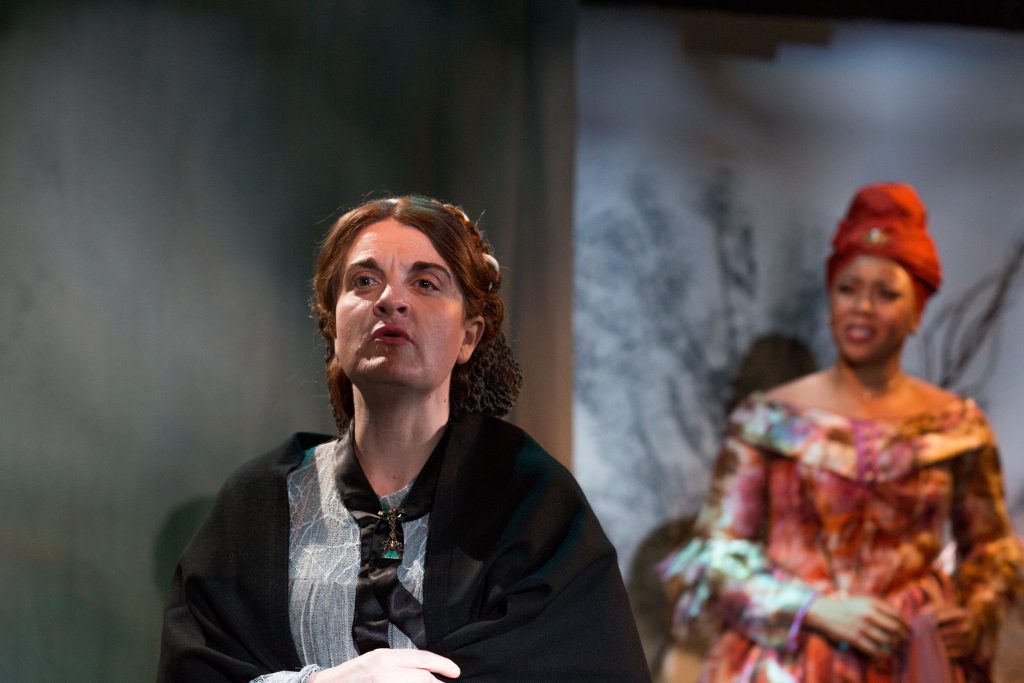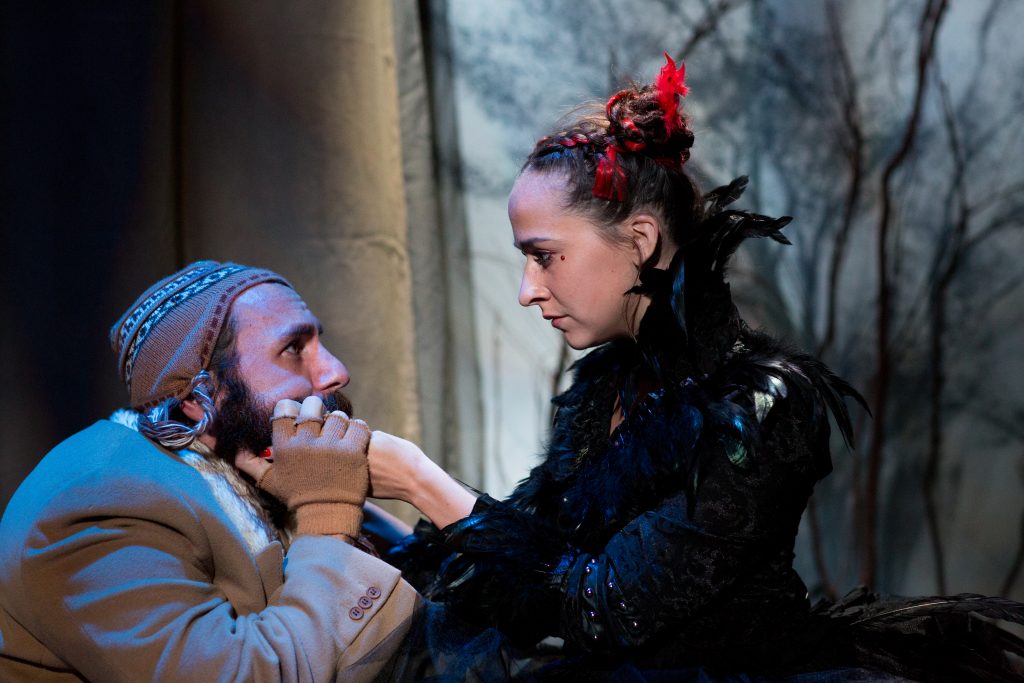Diversionary’s ‘The Moors’ Raises Gothic Satire to Dizzying Heights
What else is there to say—Diversionary’s Executive Artistic Director Matt M. Morrow has another hit on his hands in Jen Silverman’s The Moors? This smartly acted, edge-of-your-seat production of a cheeky 2016 play may defy easy categorization, but it commandeers the audience on a wild ride through the environs of comedy, tragedy, romance, thriller, and historical melodrama. Way too ambitious to settle into any of those cozy genres, The Moors creates its own arch domain, and I confess I was dismayed to have to leave it when the final curtain fell.
The plot, like nearly every plot in Baroque opera, is nothing more than a fragile portico from which the main characters declaim their emotional states, quandries, passions, and—most of all—why these matters should be of such immense importance to the audience members. When Kim Strassburger as Agatha, the older sister around whom most of the story swirls, launched into one of her bravura domineering tirades, I half expected a fabulously ornate cadenza just before her final clause.Hannah Logan as Huldey, the bespectacled younger sister whom Strassburger bullies and manipulates with chilling finesse, obsesses with breathless enthusiasm over her diary. Although it contains only quotidian accounts of her uneventful life in the sisters’ capacious house stranded in the bleak and remote moors, she warns anyone within earshot that it contains startling libidinous revelations.
Silverman’s set-up, as it should be clear by this point from the play’s title and two principal characters, is a pair of Brontë-like sisters stranded in a remote 19th-century English manor house. But, like the fragile plot, the setting is a bit of a ruse, as director Lisa Berger explained in her introductory notes. “The Moors is a current conversation disguised as a period piece.”
Into this conversation flies Whitney Brianna Thomas’ giddily extroverted Emily, hired as a governess to this childless household–I did warn the reader that Silverman’s plot is tenuous–through enticing letters from Bramwell, the mysterious and dangerous brother to Agatha and Huldey. Agatha avers that Bramwell is imprisoned in the attic, but, of course, Bramwell may be just a figment of her imagination. In the 19th century, persons who were dangerous to themselves or society were routinely kept chained in cellars or attics. In our own time, such persons are given their own talk shows on conservative media networks.
As a droll foil to Agatha, Huldey, and Emily, Gerilyn Brault’s household servant Marjory feigns subservience, but actually practices furtive insolence. Brault’s slouching posture and calculated eye-rolling communicated as incisively as her permanently exasperated tone of voice.
Silverman’s sideshow of cosmic relief (no, that is not a typo!) is the awkward romance of the household Mastiff, played with tail-wagging fervor by John DeCarlo, and an injured Moor-hen, Rachel Esther Tate’s aptly nervous but magnificently emotionally diaphanous creation. Like Charles Schulz’s Snoopy, the Mastiff engages in Kirkegaardian theological speculations, at times addressing the Deity directly, although no one else in this household evinces the slightest interest in religious considerations.Inasmuch as The Moors is part melodrama and thriller, I will not reveal the plot’s twists and turns. If you want to know how it ends and who gets bumped off, you should buy a ticket and get over to Diversionary.
Kristen Flores’ single set, a homey, inviting period drawing room complete with fireplace, aptly sets the mood even before a line is spoken. Shirley Pierson’s period costumes are as bravura as the actors’ delivery. Emily’s dazzling, brightly-hued gown with exotic red turban suggests that she has just stepped off a New Orleans Mardi Gras float, the perfect contrast to Agatha’s demure, steel-grey attire. And Pierson’s inventive, black lace and feathers creation for Tate’s Moor-hen is worthy of its own gallery show.
Berger’s hard-driven direction makes room for the love and desperation the playwright intends to surface, and her astute pacing gives the audience just enough time to ponder Silverman’s imponderables before the next surprise erupts and rivets our attention back to the stage. Karen Filijan rightly chose bright lighting for indoor scenes and mist-shrouded shadows for walks on the moors.
Even if melodrama is not your cup of tea, Silverman’s exquisite use of language—at once formal and yet brazenly confessional—is worth the price of admission. And a cast of such virtuosos is not to be taken lightly.

Ken Herman, a classically trained pianist and organist, has covered music for the San Diego Union, the Los Angeles Times’ San Diego Edition, and for sandiego.com. He has won numerous awards, including first place for Live Performance and Opera Reviews in the 2017, the 2018, and the 2019 Excellence in Journalism Awards competition held by the San Diego Press Club. A Chicago native, he came to San Diego to pursue a graduate degree and stayed.Read more…


